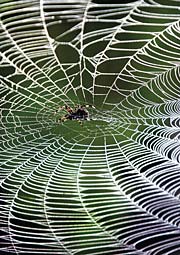Different spider, same style of spinning
Henry Fountain, New York Times, Haaretz, voila!

The Pharisees that Charles Darwin studied in the Galapagos Islands are a classic example of "split evolution". The origins of pharaoh species that lived on different islands developed differently in response to specific evolutionary forces - the types of food that were available on each island.
On the other hand, nature is full of genetically related but geographically isolated species that have similar physical or behavioral characteristics. The question in these cases is whether the common characteristics developed separately - what is known as "evolutionary convergence" - or whether they developed in a common ancestor and passed from it to the modern species.
Dr. Todd Blackledge from the University of California found an answer to the question when it comes to one complex behavioral characteristic - spider web spinning. A study he conducted with a colleague on nine closely related species living on three islands in Hawaii revealed that the different species separately developed similar styles of web spinning.
Dr. Blackledge said he did not expect to find evolutionary convergence. "Initially I was interested in finding out how diversity was created in the way the webs were spun," he said. But when he looked at the webs he found that some of them were remarkably similar to those made by other species on other islands.
In the study, published in the journal "Academy of Sciences" "The Proceedings of National", Dr. Blackledge measured the similarity between the webs based on variables such as the number of spokes and the density of the webs winding between them. He found three cases where two species living on different islands produced webs with similar structures.
With the help of genetic analysis, the researchers identified the lineage of the spiders. In at least two of the cases it turned out that there is only a distant connection between the species, a finding that supports the hypothesis that the similar web-spinning evolved separately.
Dr. Blackledge's next task is to determine the evolutionary forces that acted on the spiders and manifested in such similar behavior. One possibility is that the different species living on different islands feed on similar species of insects. "Certain forms of webs are more effective for catching certain types of prey," he said. However, other factors, such as the type of vegetation and the amount of shelter it provides, can also have an effect.
